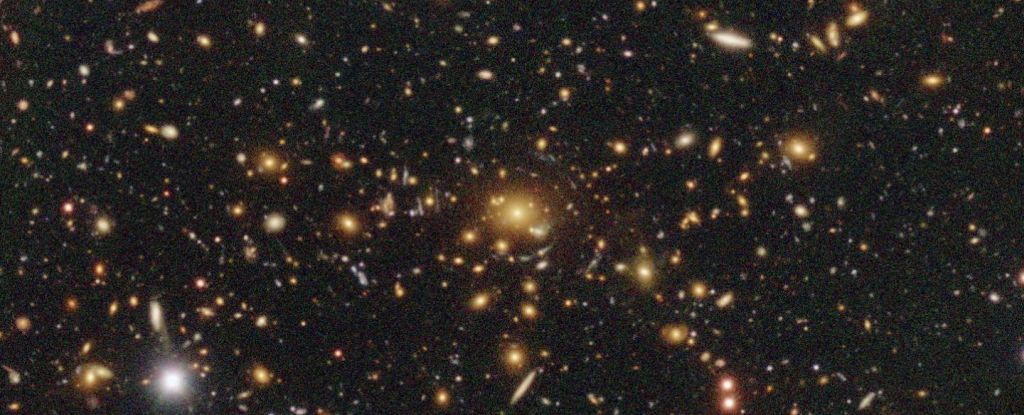A big problem concerning the Universe’s dark matter has just grown a little more intense.
Observations of the more recent Universe reveal that this elusive material is distributed differently compared to measures of its spread just after the Big Bang. It appears to be less clumpy now than it was back then – not by much, but enough to suggest that there’s something we’re missing, and that there may be some sort of fundamental mistake we’ve made in the standard cosmological model.
It is the latest and one of the most comprehensive in a series of measurements revealing the problem, known as the sigma-eight (S8 tension), detailed in five separate papers in Physical Review D. As yet there is no solution in sight.
“We’re still being fairly cautious here,” says astrophysicist Michael Strauss of Princeton University.
“We’re not saying that we’ve just discovered that modern cosmology is all wrong. The statistics show that there’s only a one in 20 chance that it’s just due to chance, which is compelling but not completely definitive. But as we in the astronomy community come to the same conclusion over multiple experiments, as we keep on doing these measurements, perhaps we’re finding that it’s real.”
The discrepancy can be found by looking at different datasets of light from the distant Universe, which reveal the distribution of dark matter. One is the cosmic microwave background (CMB). This is the faint background of microwave light that permeates the Universe; leftover radiation from the initial glow that streamed through the Universe a few hundred thousand years after the Big Bang.
The second is 6-years-worth of data from the Hyper Suprime-Cam (HSC) instrument on the Subaru Telescope in Hawaii. The researchers used HSC to conduct what is known as a weak gravitational lensing survey.
We can’t see dark matter directly. We don’t even know what it is. But the fact it exerts a gravitational influence on the Universe, bending space-time to distort the light that streams through it, means we can detect its presence.
Astronomers can look for and analyze these distortions to map the distribution of dark matter, down to extremely precise scales.
“This distortion is a really, really small effect; the shape of a single galaxy is distorted by an imperceptible amount,” says astrophysicist Roohi Dalal of Princeton University, who led one of the papers.
“But when we make that measurement for 25 million galaxies, we’re able to measure the distortion with quite high precision.”
HSC observed the sky for a total of 330 nights over the course of six years, and, in different papers, different teams analyzed the data in different ways. They returned values for S8 (the dark matter’s clumpiness) between 0.763 and 0.776 – similar to the values obtained by other weak lensing surveys.
The value for S8 given by the cosmic microwave background is noticeably higher: 0.832. This contradicts our understanding of the progression of the Universe; the cosmological standard model suggests that the distribution of matter should have started out relatively smooth and grown clumpier over time, as matter groups into galaxies and tendrils of the cosmic web.
The weak lensing results are unlikely to be produced by an error: different instruments, and different analyses, have repeatedly returned similar values.
The authors went to some serious lengths to blind themselves to their own data and protect their results from bias.
“I worked on this analysis for a year and didn’t get to see the values that were coming out,” says Dalal.
But there are other cosmological tensions – most notably the Hubble tension which is an unresolved discrepancy in different measurements of the expansion acceleration of the Universe.
So what gives? Well, there could be something wrong with our cosmological modeling. There could be something wrong with our current models of dark matter. It could be that we’re measuring something incorrectly.
It may be that, if we resolve one tension, the rest will follow. Or maybe not. But one thing is perfectly clear: there is something fundamental that we appear to be missing in our efforts to understand how the Universe evolved.
In the future, more powerful instrumentation will allow for larger surveys and even more precise measurements. It’s only through these that we’ll be able to start to obtain some answers to these fascinating problems.
The research appears in five papers in Physical Review D. They can be found here, here, here, here, and here.





